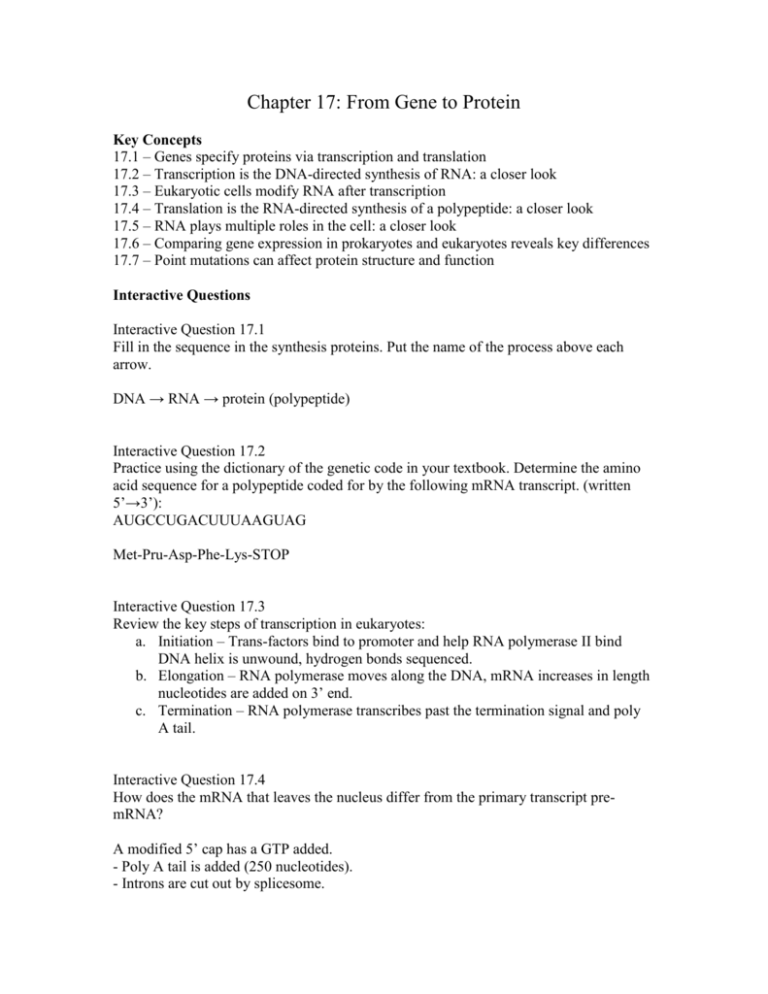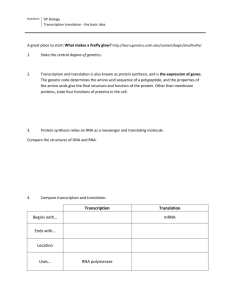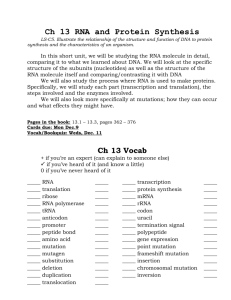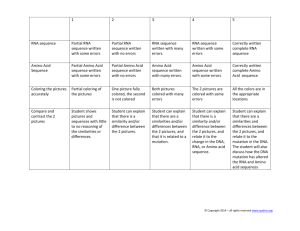Chapter 17: From Gene to Protein
advertisement

Chapter 17: From Gene to Protein Key Concepts 17.1 – Genes specify proteins via transcription and translation 17.2 – Transcription is the DNA-directed synthesis of RNA: a closer look 17.3 – Eukaryotic cells modify RNA after transcription 17.4 – Translation is the RNA-directed synthesis of a polypeptide: a closer look 17.5 – RNA plays multiple roles in the cell: a closer look 17.6 – Comparing gene expression in prokaryotes and eukaryotes reveals key differences 17.7 – Point mutations can affect protein structure and function Interactive Questions Interactive Question 17.1 Fill in the sequence in the synthesis proteins. Put the name of the process above each arrow. DNA → RNA → protein (polypeptide) Interactive Question 17.2 Practice using the dictionary of the genetic code in your textbook. Determine the amino acid sequence for a polypeptide coded for by the following mRNA transcript. (written 5’→3’): AUGCCUGACUUUAAGUAG Met-Pru-Asp-Phe-Lys-STOP Interactive Question 17.3 Review the key steps of transcription in eukaryotes: a. Initiation – Trans-factors bind to promoter and help RNA polymerase II bind DNA helix is unwound, hydrogen bonds sequenced. b. Elongation – RNA polymerase moves along the DNA, mRNA increases in length nucleotides are added on 3’ end. c. Termination – RNA polymerase transcribes past the termination signal and poly A tail. Interactive Question 17.4 How does the mRNA that leaves the nucleus differ from the primary transcript premRNA? A modified 5’ cap has a GTP added. - Poly A tail is added (250 nucleotides). - Introns are cut out by splicesome. - Exons are attached together. Interactive Question 17.5 Using some of the codons and the amino acids you identified in Interactive Question 17.2, fill in the following table. RNA Triplet 3’→5’ TAC GGA TTC ATC mRNA Codon 5’→3’ AUG CCU AAG UAG Anticodon 3’→5’ Amino Acid UAC GGA UUC AUC Methionine Protive Lysine STOP Interactive Question 17.6 1. 2. 3. 4. Codon Recognition Peptide Bond Formation Translation Termination a. growing polypeptide chain b. tRNA with amino acid c. large subunit of ribosomes d. A site e. small subunit f. 5’ end mRNA g. peptide bond formation h. E site i. release factor j. termination codon k. P site l. free polypeptide Interactive Question 17.8 Fill in the functions for the following types of RNA molecules a. b. c. d. e. mRNA – Carries the code from DNA that specifies the amino acid tRNA – Carries a specific amino acid to its position in a polypeptide rRNA – Plays catalytic (ribozyme) roles and structural roles in ribosomes snRNA – Small nuclear RNA, part of the spliceosomes, splices mRNA SRP RNA – Signal recognition particle that binds to signal peptides bound to endoplasmic reticulum f. snoRNA (small nucleolar RNA) – Aids in processing pre-RNA transcript in nucleolus g. siRNA (small interfering RNA) and miRNA (microRNA) – small interfering RNA Interactive Question 17.9 Define the following, and explain what type of point mutation could cause each of these mutations. a. silent mutation – A base pair substitution that produces a codon that still codes for the same amino acid b. missense mutation – Base pair substitution or frameshift mutation that results in a codon for a different amino acid c. nonsense mutation – Base pair substitutions or frameshift mutation that creates a stop codon and prematurely terminates translation d. frameshift mutation – An insertion or deletion of one, two, or more, than three mucleotides that disrupts the reading frame and creates extensive missense or nonsense mutations Structure Yo’ Knowledge 1. Template Location Molecules involved Enzymes involved Control – start and stop Product Product processing Energy source Transcription DNA Nucleus (eukaryotes) RNA nucleotides, DNA template strands, RNA polymerase, transcription factors RNA polymerase, ribozymes Transcription factors, TATA box, poly A Primary transcript (premRNA) RNA processing: 5’ cap, poly A tail, splicing RIbonucleoside, triphosphate Translation RNA Cytoplasm Amino acids, tRNA, mRNA, ribosomes, ATP, GTP, enzymes, initiation elongation Aminoacyl-tRNA synthetase Initiation factors, AUG, stop codons, release factors Protein (polypeptide) Spontaneous folding, disulfide bridges, cleaving, structure ATP, GTP 2. The genetic code is the RNA triplets that code for amino acids. The order of these codons is specified by the sequence of nucleotides on DNA, which is transcribed into the codons found on mRNA and translated into their corresponding amino acids. There are 64 possible mRNA codons created from the our nucleotides used in the triplet code (43) Redundancy of the code refers to the fact that several triplets may code for the same amino acid. Often these triplets differ only in the third nucleotide. The wobble phenomenon explains the fact that there are only about 45 different tRNA molecules that pair with the 61 possible codons (three codons are always stop codons). The third nucleotide of many tRNAs can pair with more than one base. Because of the redundancy of the genetic code, these wobble tRNAs still place the correct amino acid in position. 3. POINT MUTATIONS base-pair substitutions may have may be may be due to insertions or deletions spontaneous small effect on protein usually have during due to large effect on protein DNA repair, replication, recombination redundancy of code depends on properties of replacement amino acid called silent mutation called may be chemical, physical if location of replacement amino cid whether in active site missense mutation mutagens create stop codon called nonsense mutation such as base analogs, X-ray, UV Test Yo’ Knowledge 1. d – ornithine or citrulline (p. 310) 2. a – DNA to RNA (p. 311) 3. b – CAU (p. 314) 4. e – begins transcription at a promoter sequence and moves along the template strand of DNA, elongating an RNA molecule in a 5’ 3’ direction. (p. 316) 5. c – It depends on the orientation of the RNA polymerase, whose position is determined by particular sequences of nucleotides within the promoter. 6. b – RNA polymerase (p. 328) 7. c – Assemblies of protein and snRNPs, called spliceosomes, may catalyze splicing. (p. 328) 8. c – snRNA (p. 319) 9. b – 200 (p. 339) 10. a – exons (p. 320) 11. d – Introns provide more area where crossing over may occur and thus increase the probability of exon shuffling between alleles. (p. 316) 12. d – an RNA molecule that functions as an enzyme. (p. 323) 13. d – snRNA (p. 317) 14. c – gene for transcription factor (p. 314) 15. b – binds to its specific amino acid in the active site of an aminoacyl-tRNA synthetase (p. 328) 16. e – 5-4-2-1-3 (p. 324) 17. e – all of the above (p. 329) 18. b – rRNA (p. 320) 19. b – It lines up in the 5’3’ direction along the 5’3’ mRNA strand. (p. 317) 20. a – the addiction of sugars or lipids in certain amino acids. (p.310) 21. a – the action of several ribosomes in a string, called a polyribosome. (p.313) 22. d – would be the first 20 or so amino acids of a protein destined for a membrane location of secretion from the cell. (p.315) 23. e – all of the above (p. 323) 24. b – The substitution must involve three nucleotide pairs, otherwise the reading frame is altered. (p. 318) created by doo lim









